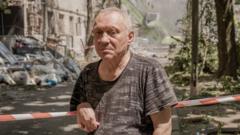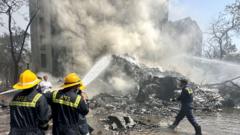Spain is grappling with the aftermath of catastrophic floods that have resulted in more than 200 fatalities and numerous individuals missing.
Spain's Catastrophic Flooding: A Visual Chronicle of Destruction

Spain's Catastrophic Flooding: A Visual Chronicle of Destruction
Flash floods lead to over 200 casualties in Spain, as emergency efforts continue in Valencia.
Emergency response teams, alongside military units, are engaged in extensive search and rescue missions in the most affected areas. As clean-up efforts begin, images illustrating the destruction caused by torrential rains reveal the intense impact on local communities.
Warnings for additional rainfall have been issued, particularly for Huelva's coastal regions, urging residents to remain indoors for their safety. The devastation is clearly visible, with before and after photographs showcasing the chaos of the floods that uprooted buildings, littered streets with debris, and obliterated bridges.
In the Valencia region, hardest hit by the deluge, cars were precariously swept away onto major thoroughfares and railway lines. Many of those who lost their lives were caught on the roads, often returning home from work when the floods struck unexpectedly.
The images of a tunnel connecting Benetusser and Alfafar illustrate the sheer magnitude of the flooding, as it became choked with vehicles pulled in by the rushing water.
Valencia, Spain's third-largest city, received an equivalent of a year's rainfall in just a matter of hours on Wednesday, leading to extensive damage. Train services connecting Madrid and Valencia have been suspended due to the destruction of critical infrastructure, with numerous railway tracks either heavily damaged or entirely washed away.
In various neighborhoods, streets and homes are now unrecognizable, buried under layers of mud and stones, as exemplified in Letur to the southwest of Valencia. Satellite imagery reveals the radical transformation of the affected coastal towns, providing a stark visual representation of the water's ferocity.
As Spain continues to deal with the aftermath of these floods, the focus remains on recovery and support for the thousands impacted by this natural disaster.
Warnings for additional rainfall have been issued, particularly for Huelva's coastal regions, urging residents to remain indoors for their safety. The devastation is clearly visible, with before and after photographs showcasing the chaos of the floods that uprooted buildings, littered streets with debris, and obliterated bridges.
In the Valencia region, hardest hit by the deluge, cars were precariously swept away onto major thoroughfares and railway lines. Many of those who lost their lives were caught on the roads, often returning home from work when the floods struck unexpectedly.
The images of a tunnel connecting Benetusser and Alfafar illustrate the sheer magnitude of the flooding, as it became choked with vehicles pulled in by the rushing water.
Valencia, Spain's third-largest city, received an equivalent of a year's rainfall in just a matter of hours on Wednesday, leading to extensive damage. Train services connecting Madrid and Valencia have been suspended due to the destruction of critical infrastructure, with numerous railway tracks either heavily damaged or entirely washed away.
In various neighborhoods, streets and homes are now unrecognizable, buried under layers of mud and stones, as exemplified in Letur to the southwest of Valencia. Satellite imagery reveals the radical transformation of the affected coastal towns, providing a stark visual representation of the water's ferocity.
As Spain continues to deal with the aftermath of these floods, the focus remains on recovery and support for the thousands impacted by this natural disaster.




















